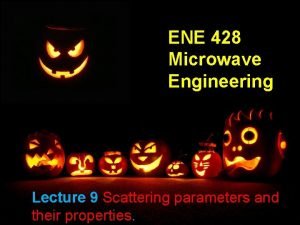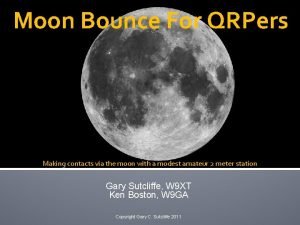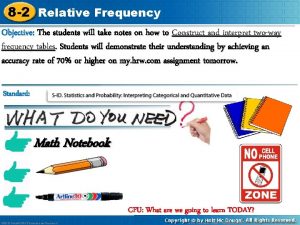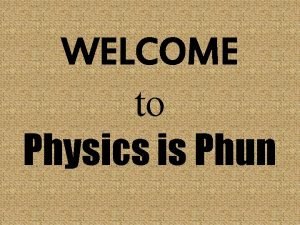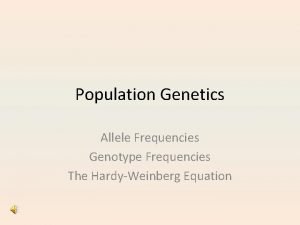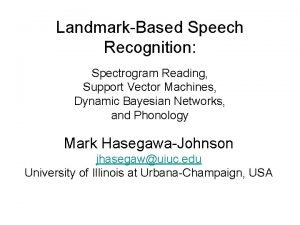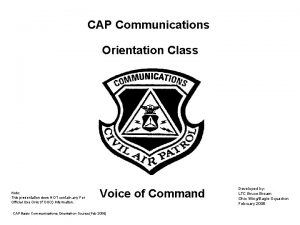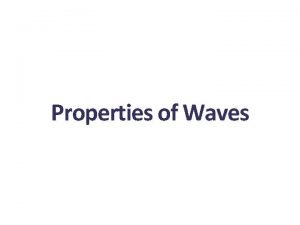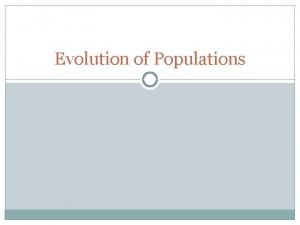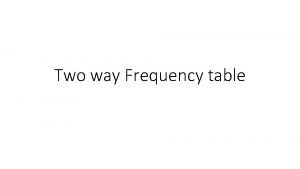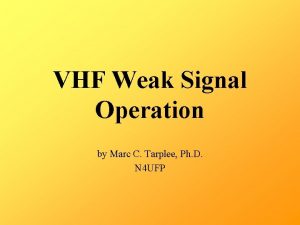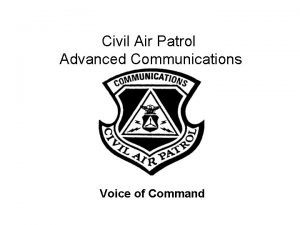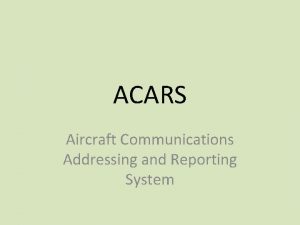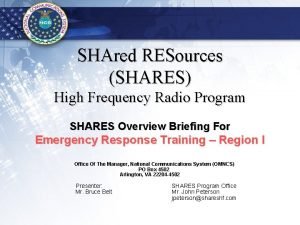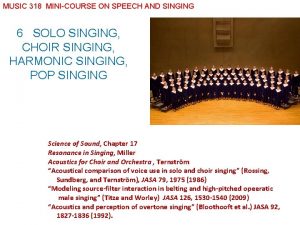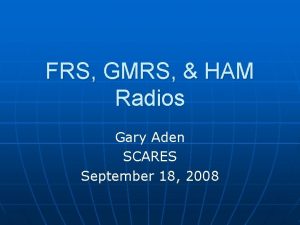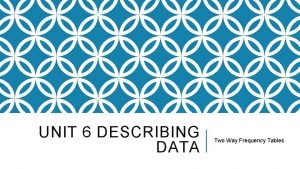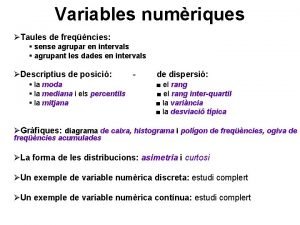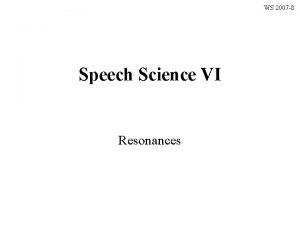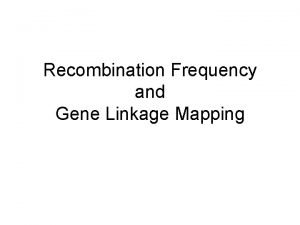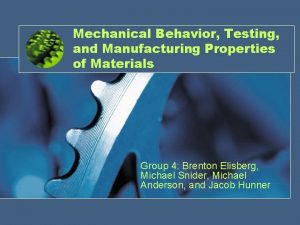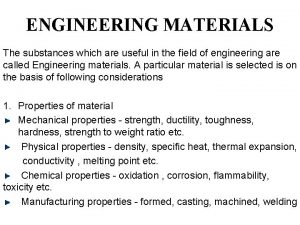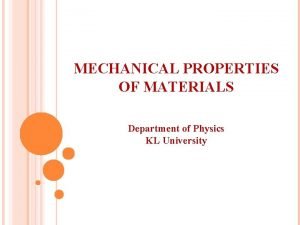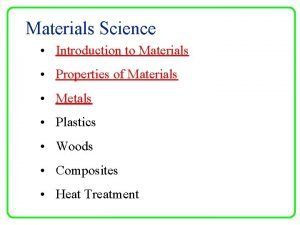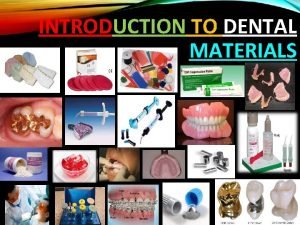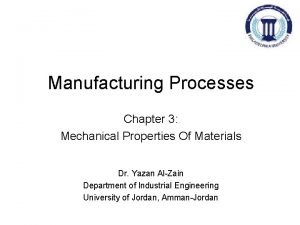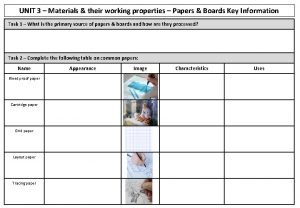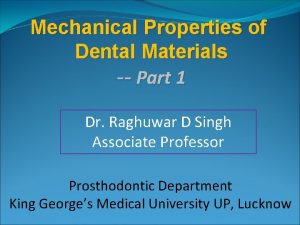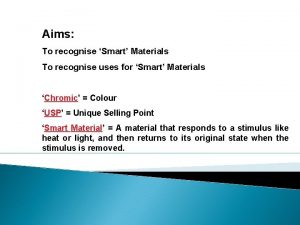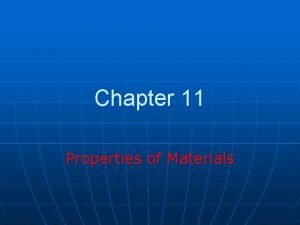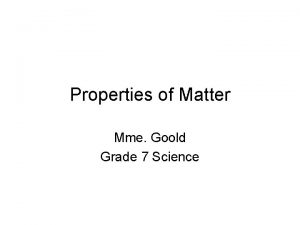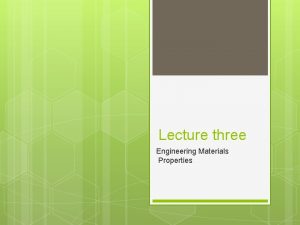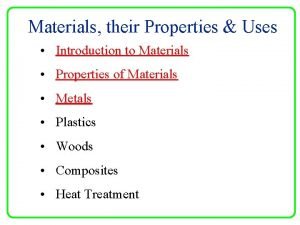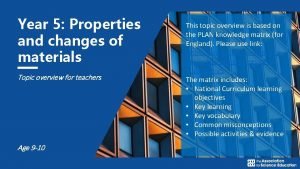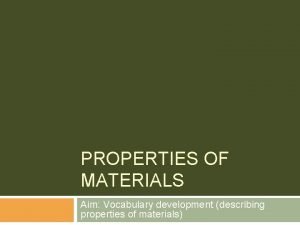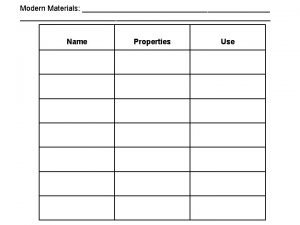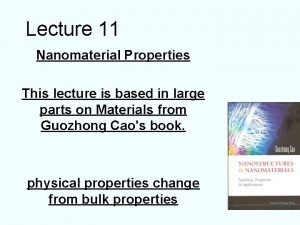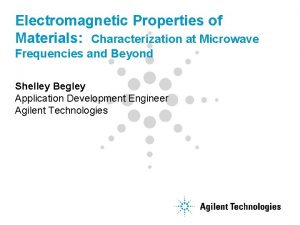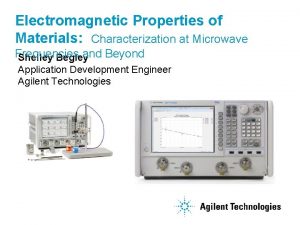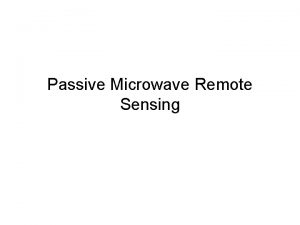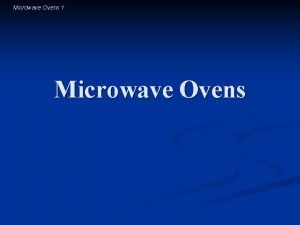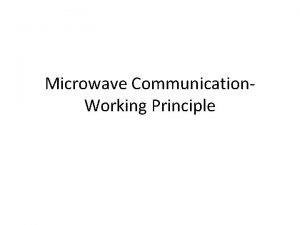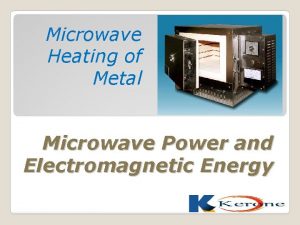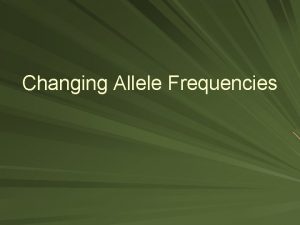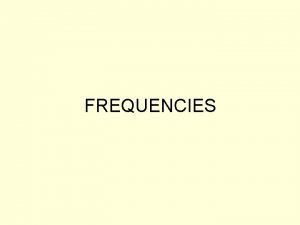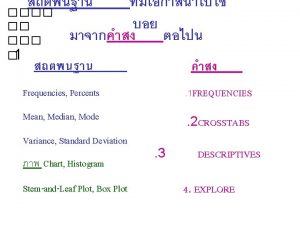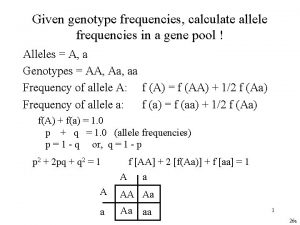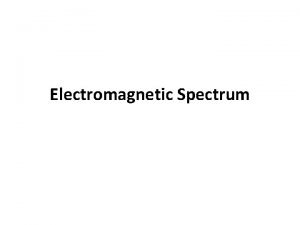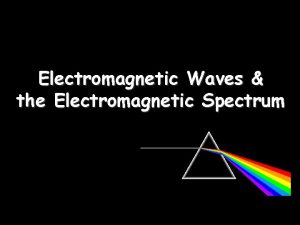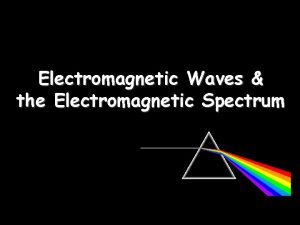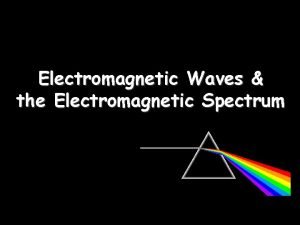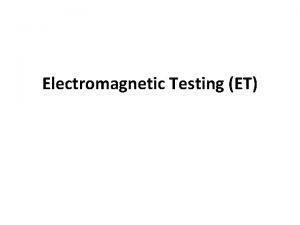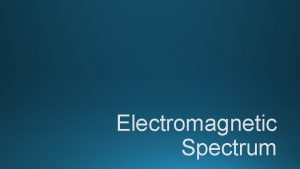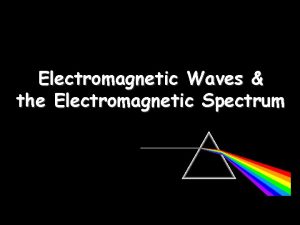Electromagnetic Properties of Materials Characterization at Microwave Frequencies



















































- Slides: 51

Electromagnetic Properties of Materials: Characterization at Microwave Frequencies and Beyond Shelley Begley Application Development Engineer Agilent Technologies

Agenda Definitions Measurement Techniques Coaxial Probe Transmission Line Free-Space Resonant Cavity Summary

Definitions Permittivity is a physical quantity that describes how an electric field affects and is affected by a dielectric medium and is determined by the ability of a material to polarize in response to an applied electric field, and thereby to cancel, partially, the field inside the material. Permittivity relates therefore to a material's ability to transmit (or "permit") an electric field…The permittivity of a material is usually given relative to that of vacuum, as a relative permittivity, (also called dielectric constant in some cases)…. - Wikipedia

Permittivity and Permeability Definitions Permittivity (Dielectric Constant) interaction of a material in the presence of an external electric field.

Permittivity and Permeability Definitions Permittivity (Dielectric Constant) interaction of a material in the presence of an external electric field.

Permittivity and Permeability Definitions Permittivity (Dielectric Constant) interaction of a material in the presence of an external electric field. Permeability interaction of a material in the presence of an external magnetic field.

Permittivity and Permeability Definitions Permittivity (Dielectric Constant) interaction of a material in the presence of an external electric field. Permeability interaction of a material in the presence of an external magnetic field.

Electromagnetic Field Interaction Electric Fields Permittivity STORAGE MUT STORAGE Magnetic Fields Permeability

Electromagnetic Field Interaction Electric Fields Permittivity STORAGE LOSS MUT STORAGE LOSS Magnetic Fields Permeability

Loss Tangent Dissipation Factor Quality Factor

Relaxation Constant t Water at 20 o C t = Time required for 1/e of an aligned system to return to equilibrium or random state, in seconds. 100 10 most energy is lost at 1/t 1 1 10 100 f, GHz

Techniques Transmissi on LIne Free Space Coaxial Probe Resonant Cavity

Which Technique is Best? It Depends…

Which Technique is Best? It Depends… on ü Frequency of interest ü Expected value of er and mr ü Required measurement accuracy

Which Technique is Best? It Depends… on ü Frequency of interest ü Expected value of er and mr ü Required measurement accuracy ü Material properties (i. e. , homogeneous, isotropic) ü Form of material (i. e. , liquid, powder, solid, sheet) ü Sample size restrictions

Which Technique is Best? It Depends… on ü Frequency of interest ü Expected value of er and mr ü Required measurement accuracy ü Material properties (i. e. , homogeneous, isotropic) ü Form of material (i. e. , liquid, powder, solid, sheet) ü Sample size restrictions ü Destructive or non-destructive ü Contacting or non-contacting ü Temperature

Measurement Techniques vs. Frequency and Material Loss Hig h Coaxial Probe Transmission line Mediu m Free Space Resonant Cavity Low 50 MHz Low frequency Frequency 5 GHz RF 20 GHz Microwave 40 GHz 60 GHz 500+ GHz Millimeter-wave

Measurement Techniques vs. Frequency and Material Loss Hig h Coaxial Probe Mediu m Low 50 MHz Low frequency Frequency 5 GHz RF 20 GHz Microwave 40 GHz 60 GHz 500+ GHz Millimeter-wave

Measurement Techniques vs. Frequency and Material Loss Hig h Coaxial Probe Mediu m Low 50 MHz Low frequency Frequency 5 GHz RF 20 GHz Microwave 40 GHz 60 GHz 500+ GHz Millimeter-wave

Measurement Techniques vs. Frequency and Material Loss Hig h Coaxial Probe Transmission line Mediu m Free Space Low 50 MHz Low frequency Frequency 5 GHz RF 20 GHz Microwave 40 GHz 60 GHz 500+ GHz Millimeter-wave

Measurement Techniques vs. Frequency and Material Loss Hig h Coaxial Probe Transmission line Mediu m Free Space Low 50 MHz Low frequency Frequency 5 GHz RF 20 GHz Microwave 40 GHz 60 GHz 500+ GHz Millimeter-wave

Measurement Techniques vs. Frequency and Material Loss Hig h Coaxial Probe Transmission line Mediu m Free Space Resonant Cavity Low 50 MHz Low frequency Frequency 5 GHz RF 20 GHz Microwave 40 GHz 60 GHz 500+ GHz Millimeter-wave

Coaxial Probe System Computer (Optional for PNA or ENA-C) Network Analyzer (or E 4991 A Impedance Analyzer) GP-IB or LAN 85070 E Software (included in kit) Calibration is required 85070 E Dielectric Probe

Coaxial Probe Material assumptions: • effectively infinite thickness • non-magnetic • isotropic Reflection 1 (S 1 ) er • homogeneous • no air gaps or bubbles

Three Probe Designs High Temperature Probe • 0. 200 – 20 GHz (low end 0. 01 GHz with impedance analyzer) • Withstands -40 to 200 degrees C • Survives corrosive chemicals • Flanged design allows measuring flat surfaced solids.

Three Probe Designs Slim Form Probe • 0. 500 – 50 GHz • Low cost consumable design • Fits in tight spaces, smaller sample sizes • For liquids and soft semi-solids only

Three Probe Designs Performance Probe Combines rugged high temperature performance with high frequency performance, all in one slim design. • 0. 500 – 50 GHz • Withstands -40 to 200 degrees C • Hermetically sealed on both ends, OK for autoclave • Food grade stainless steel

Coaxial Probe Example Data

Coaxial Probe Example Data

Martini Meter! Infometrix, Inc.

Transmission Line System Computer (Optional for PNA or ENA-C) Network Analyzer GPIB or LAN 85071 E Materials Measurement Software Calibration is Sample holder required connected between coax cables

Transmission Line Sample Holders Coaxial Waveguide

Transmission Line Material assumptions: • sample fills fixture cross section • no air gaps at fixture walls • flat faces, perpendicular to long axis l Reflection (S 11 ) er and mr Transmissio n (S 21 ) • Known thickness > 20/360 λ

Transmission Free-Space System Computer (Optional for PNA or ENA-C) Network Analyzer GP-IB or LAN 85071 E Materials Measurement Software Calibration is required Sample holder fixtured between two antennae

Non-Contacting method for High or Low Temperature Tests. Free Space with Furnace

Transmission Free-Space Material assumptions: • Flat parallel faced samples • Sample in non-reactive region • Beam spot is contained in sample l • Known thickness > 20/360 λ Reflection (S 11 ) er and mr Transmission (S 21 )

Transmission Example Data

Resonant Cavity System Computer (Optional for PNA or ENA-C) Network Analyzer GP-IB or LAN Resonant Cavity Software No calibration Resonant Cavity with sample required connected between ports.

Resonant Cavity Fixtures Agilent Split Cylinder Resonator IPC TM-6502. 5. 5. 5. 13 ASTM 2520 Waveguide Resonators Split Post Dielectric Resonators from QWED

Resonant Cavity Technique empty cavity fc = Resonant Frequency of Empty Cavity Qc fs = Resonant Frequency of Filled Cavity Qc = Q of Empty Cavity Qs = Q of Filled Cavity S 21 fc Vs = Volume of Empty Cavity Vc = Volume of Sample ASTM 2520 f

Resonant Cavity Technique fc = Resonant Frequency of Empty Cavity sample inserted empty cavity Qc fs = Resonant Frequency of Filled Cavity Q s Qc = Q of Empty Cavity Qs = Q of Filled Cavity S 21 fs Vs = Volume of Empty Cavity Vc = Volume of Sample ASTM 2520 fc f

Resonant Cavity Technique fc = Resonant Frequency of Empty Cavity sample inserted empty cavity Qc fs = Resonant Frequency of Filled Cavity Q s Qc = Q of Empty Cavity Qs = Q of Filled Cavity S 21 fs Vs = Volume of Empty Cavity Vc = Volume of Sample ASTM 2520 fc f

Resonant Cavity Technique fc = Resonant Frequency of Empty Cavity sample inserted empty cavity Qc fs = Resonant Frequency of Filled Cavity Q s Qc = Q of Empty Cavity Qs = Q of Filled Cavity S 21 fs Vs = Volume of Empty Cavity Vc = Volume of Sample ASTM 2520 fc f

Resonant Cavity Example Data

Resonant vs. Broadband Transmission Techniques Resonant Broadband Yes No er” resolution ≤ 10 -4 er” resolution ≥ 10 -2 -10 -3 Yes No Thin Films and Sheets 10 GHz sample thickness <1 mm 10 GHz optimum thickness ~ 5 -10 mm Calibration Required No Yes Measurement Frequency Coverage Single Frequency Broadband or Banded Low Loss materials

Summary Technique and Strengths Coaxial Probe Broadband er Best for liquids, semi-solids Transmission Line Broadband er & mr Best for solids or powders Transmission Free Space Broadband, mm-wave er & mr Non-contacting Resonant Cavity Single frequency er High accuracy, Best for low loss, or thin samples

Microwave Dielectric Measurement Solutions Model Number Description 85070 E Dielectric Probe Kit 020 High Temperature Probe 030 050 Slim Form Probe Performance Probe 85071 E Materials Measurement Software 100 200 300 E 01 85072 A Free Space Calibration E 03 Reflectivity Software Resonant Cavity Software 75 -110 GHz Free Space Fixture 2. 5 GHz Split Post Dielectric Resonator E 04 5 GHz Split Post Dielectric Resonator 10 GHz Split Cylinder Resonant Cavity

For More Information Visit our website at: www. agilent. com/find/materials For Product Overviews, Application Notes, Manuals, Quick Quotes, international contact information…

For More Information Visit our website at: www. agilent. com/find/materials For Product Overviews, Application Notes, Manuals, Quick Quotes, international contact information… Call our on-line technical support: +1 800 829 -4444 For personal help for your application, formal quotes, to get in touch with Agilent field engineers in your area.

References R N Clarke (Ed. ), “A Guide to the Characterisation of Dielectric. Materials at RF and Microwave Frequencies, ” Published by The Institute of Measurement & Control (UK) & NPL, 2003 J. Baker-Jarvis, M. D. Janezic, R. F. Riddle, R. T. Johnk, P. Kabos, C. Holloway, R. G. Geyer, C. A. Grosvenor, “Measuring the Permittivity and Permeability of Lossy Materials: Solids, Liquids, Metals, Building Materials, and Negative-Index Materials, ” NIST Technical Note 15362005 “Test methods for complex permittivity (Dielectric Constant) of solid electrical insulating materials at microwave frequencies and temperatures to 1650°, ” ASTM Standard D 2520, American Society for Testing and Materials Janezic M. and Baker-Jarvis J. , “Full-wave Analysis of a Split-Cylinder Resonator for Nondestructive Permittivity Measurements, ” IEEE Transactions on Microwave Theory and Techniques vol. 47, no. 10, Oct 1999, pg. 2014 -2020 J. Krupka , A. P. Gregory, O. C. Rochard, R. N. Clarke, B. Riddle, J. Baker-Jarvis, “Uncertainty of Complex Permittivity Measurement by Split-Post Dielectric Resonator Techniques, ” Journal of the European Ceramic Society No. 10, 2001, pg. 2673 -2676 “Basics of Measureing the Dielectric Properties of Materials”. Agilent application note. 5989 -2589 EN, April 28, 2005

Transmission Algorithms Algorithm Measured S-parameters Output Nicolson-Ross S 11, S 21, S 12, S 22 er and mr Precision (NIST) S 11, S 21, S 12, S 22 er Fast S 21, S 12 er (85071 E also has three reflection algorithms)
 Scattering matrix in microwave engineering
Scattering matrix in microwave engineering Indirect characterization
Indirect characterization Direct characterization meaning
Direct characterization meaning Moon bounce frequencies
Moon bounce frequencies What is joint relative frequency
What is joint relative frequency Scale of electromagnetic waves
Scale of electromagnetic waves What is conditional relative frequency
What is conditional relative frequency Formant frequencies
Formant frequencies Allele frequency
Allele frequency Formant frequencies
Formant frequencies How to find conditional relative frequency
How to find conditional relative frequency Ef johnson 5112
Ef johnson 5112 A piano emits frequencies that range
A piano emits frequencies that range Allele frequencies
Allele frequencies Two way relative frequency table definition
Two way relative frequency table definition Hf beacon frequencies
Hf beacon frequencies Marginal frequency table
Marginal frequency table Jt6m frequencies
Jt6m frequencies Capr 100-1
Capr 100-1 Acars message format
Acars message format Shares hf frequencies
Shares hf frequencies Formant frequencies
Formant frequencies Frs and gmrs frequencies
Frs and gmrs frequencies Relative frequency two way table
Relative frequency two way table Poligon de frequencies
Poligon de frequencies Formant frequencies
Formant frequencies Recombination rate
Recombination rate Natural materials and man made materials
Natural materials and man made materials Natural materials
Natural materials Differentiate adopting materials and adapting materials
Differentiate adopting materials and adapting materials A material is useful when
A material is useful when Direct materials budget with multiple materials
Direct materials budget with multiple materials Manufacturing properties of materials
Manufacturing properties of materials Properties of engineering materials
Properties of engineering materials Lateral strain
Lateral strain Properties of materials examples
Properties of materials examples Los dientes
Los dientes Thermal conductivity of dental materials
Thermal conductivity of dental materials Manufacturing properties of materials
Manufacturing properties of materials Bleedproof paper appearance
Bleedproof paper appearance Elastic range
Elastic range Properties of smart and modern materials
Properties of smart and modern materials Properties of materials examples
Properties of materials examples Natural science grade 7 term 2 notes pdf
Natural science grade 7 term 2 notes pdf Matter and materials grade 7
Matter and materials grade 7 Optical properties of engineering materials
Optical properties of engineering materials Properties of materials examples
Properties of materials examples 5 properties of materials
5 properties of materials Properties of materials vocabulary
Properties of materials vocabulary Properties of modern materials
Properties of modern materials Natural science grade 7 matter and materials
Natural science grade 7 matter and materials Mechanical properties of nano materials
Mechanical properties of nano materials
